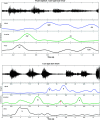Characterizing Articulation in Apraxic Speech Using Real-Time Magnetic Resonance Imaging
- PMID: 28314241
- PMCID: PMC5548083
- DOI: 10.1044/2016_JSLHR-S-15-0112
Characterizing Articulation in Apraxic Speech Using Real-Time Magnetic Resonance Imaging
Abstract
Purpose: Real-time magnetic resonance imaging (MRI) and accompanying analytical methods are shown to capture and quantify salient aspects of apraxic speech, substantiating and expanding upon evidence provided by clinical observation and acoustic and kinematic data. Analysis of apraxic speech errors within a dynamic systems framework is provided and the nature of pathomechanisms of apraxic speech discussed.
Method: One adult male speaker with apraxia of speech was imaged using real-time MRI while producing spontaneous speech, repeated naming tasks, and self-paced repetition of word pairs designed to elicit speech errors. Articulatory data were analyzed, and speech errors were detected using time series reflecting articulatory activity in regions of interest.
Results: Real-time MRI captured two types of apraxic gestural intrusion errors in a word pair repetition task. Gestural intrusion errors in nonrepetitive speech, multiple silent initiation gestures at the onset of speech, and covert (unphonated) articulation of entire monosyllabic words were also captured.
Conclusion: Real-time MRI and accompanying analytical methods capture and quantify many features of apraxic speech that have been previously observed using other modalities while offering high spatial resolution. This patient's apraxia of speech affected the ability to select only the appropriate vocal tract gestures for a target utterance, suppressing others, and to coordinate them in time.
Figures









References
-
- Aichert I., & Ziegler W. (2004). Syllable frequency and syllable structure in apraxia of speech. Brain and Language, 88, 148–159. - PubMed
-
- Bartle-Meyer C. J., Goozée J. V., Murdoch B. E., & Green J. R. (2009). Kinematic analysis of articulatory coupling in acquired apraxia of speech post-stroke. Brain Injury, 23, 133–145. - PubMed
-
- Bartle-Meyer C. J., Murdoch B. E., & Goozée J. V. (2009). An electropalatographic investigation of linguopalatal contact in participants with acquired apraxia of speech: A quantitative and qualitative analysis. Clinical Linguistics & Phonetics, 23, 688–716.
-
- Bresch E., Kim Y. C., Nayak K., Byrd D., & Narayanan S. (2008). Seeing speech: Capturing vocal tract shaping using real-time MRI. IEEE Signal Processing Magazine, 25, 123–132.
Publication types
MeSH terms
Grants and funding
LinkOut - more resources
Full Text Sources
Other Literature Sources
Medical

